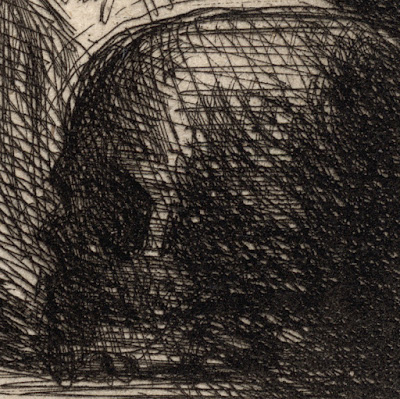Charles Émile Jacque (1813–94)
“Man reading
beside a skull” (descriptive title only), 1866, attributed on the plate to José
de Ribera (1591–1652)
Etching on fine
wove (Japan) paper, trimmed with narrow margins and lined on a conservator’s
support sheet
Size: (sheet)
13.4 x 12.3 cm; (plate) 12.1 x 11.3 cm; (image borderline) 11.5 x 10.5 cm
Inscribed
within the image borderline at the lower left with the artist's initials, "C. J." (shown in reverse on
the book page) and "ARibera 1621”; numbered outside the image borderline at
lower left: “1.”
The British
Museum offers the following description of this print:
“Man seen
half-length, facing the viewer, reading a book laid on a table; his head rests
on his left hand; a skull on the right.” (http://www.britishmuseum.org/research/collection_online/collection_object_details.aspx?objectId=3360514&partId=1&searchText=Jos%25u00e9+de+Ribera&people=119978&page=1)
The curator of
the British Museum gives the important and interesting advice that J-J Guiffrey
(1866) in “LÓeuvre de Ch. Jacque: Catalogue de ses eaux-fortes et pointes seches”
does not describe this print “despite having been made in 1845/47 as part of a
series of pastiches which he records” (ibid).
The curator of
the British Museum advises that this print and the others from the same series
referencing José de Ribera were “a group of prints commissioned to Jacque
c.1845/47 and signed as Ribera; however they are pastiches rather than copies
after the master.” The curator also cites Henri Beraldi (1885) “Les Graveurs du
dix-neuvième siècle”, vol. VIII, Paris, p. 180. (http://www.britishmuseum.org/research/collection_online/collection_object_details.aspx?objectId=3360532&partId=1&searchText=Moine&people=119978&page=1)
Beraldi 1885-92
56bis (Henri Beraldi, 1885 “Les Graveurs du dix-neuvième siècle”, 12 vols plus
supplement, Paris); Guiffrey 1866 not described; IFF 509 (Inventaire du Fonds
Français: Bibliothèque Nationale, Département des Estampes, Paris, 1930)
Condition: rich
and well-printed impression but with beginning signs of wear to the plate, on
fine wove (Japan) paper, trimmed with narrow margins and lined on a
conservator’s support sheet. Near pristine condition (i.e. there are no stains,
tears, holes, abrasions, folds or foxing).
I am selling
this original etching by Jacque after José de Ribera for AU$277 (currently US$185.15/EUR167.52/GBP147.47 at the
time of posting this listing) including Express Mail postage and handling to
anywhere in the world, but not (of course) any import duties/taxes imposed by
some countries.
If you are interested in purchasing this
arresting image, please contact me (oz_jim@printsandprinciples.com) and I will
send you a PayPal invoice to make the payment easy.
There is a skull portrayed in the murky shadows at the lower right
corner of this print. Such a subject to be included in an image referencing the
time of José de Ribera—the 17th century—was not by chance nor was it
considered an incidental feature. The whole meaning of images with skulls in
them was grounded on the significance of what skulls symbolise: death (and an
array of other associated meanings). By the time that Jacque was making images,
the symbolism of skulls was so ingrained that even a slight indication of one
was enough for learned folk to understand what the image was all about. In
truth, however, the symbolism was not specifically death but rather a codified
warning that “things” die. This is the notion of vanitas which is Latin for “emptiness.”
Although I may be wrong, the meaningful point of this print of a man reading beside
a skull is that his earthly pursuit of knowledge is ultimately worthless. He will
die and he will die with the knowledge that he has procured.
What I like
about this image is the arrangement of the skull on the desk. Jacque, in the manner
of Ribera, has cast the skull in shadow. Moreover, the skull seems to be
reading what the man is reading from the shadows. For me, this treatment of a skull
is fascinating as it presents death lurking in the shadows while the temporal
world of an everyday pleasure—reading—is clearly seen in the light. Arguably,
there is a play of dualities here between the meaning of light and the meaning
of shadow.





No comments:
Post a Comment
Please let me know your thoughts, advice about inaccuracies (including typos) and additional information that you would like to add to any post.